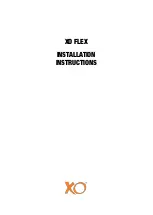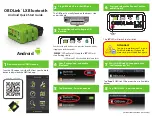
5
4
Liquid nitrogen is extremely cold. Make sure to wear proper gear before operation. Avoid spilling
liquid nitrogen over the vacuum port as this can shrink the seal and allow air to leak into the vacuum
space causing premature vacuum failure. To ensure maximum performance from your MVE Vapor
Shipper simply follow the listed steps prior to shipping to final destination:
1. Open container that the Vapor Shipper is in, open the lid, and remove cork/cover/accessories.
Lift cork/cover straight up (do not twist).
2. Fill unit to bottom of neck tube.
a. If you are working with a warm vessel, it is MVE’s recommendation to slowly add small
amount of liquid to the bottom of unit, and allow it to sit until the liquid nitrogen stops
rapidly boiling to cool the unit. Position the vacuum port facing away from the operator or
other personnel.
b. To obtain the optimized Hold time. You will need to refill the unit to bottom of the neck
more than once until the liquid level is steady.
c. Follow established safety practices and procedures for transferring LN2.
d. Fill the vessel with a funnel or transfer line when possible. Transfer using LN2 hose with
phase separator or pouring container using a funnel.
e. If you are filling your vessel from a pressurized source, make sure it is a low pressure
source (22 psi or below).
3. Replace cork/cover and allow unit to reach thermal equilibrium /charge for minimal 24 hours.
a. Refer to
UTILIZING THE QWICK CHARGE TECHNOLOGY
section for expedited charge solution.
b. If there is excessive frost or sweating on the outside vessel after the first few hours, it
would indicate either a weak or no vacuum. Examine the unit carefully.
4. Pour off excess liquid just prior to shipment.
a. If necessary to completely dispense all liquid nitrogen, invert the unit until liquid nitrogen
dripping has stopped, set the unit upright and view if any liquid nitrogen pools at the
bottom of the unit. If liquid nitrogen starts to pool, invert the unit again. Repeat as
necessary until all liquid nitrogen is removed from the unit, in accordance with ICAO
Packaging Instruction 202.
5. Weigh unit and record.
a. To ensure a proper charging process is conducted, obtain both empty and charged
weights. Verify the differential between empty and charged weights is close to data in
Table 1. The differential can be calculated by using Equation 1.
Differential = Charged Weight — Empty Weight
Equation 1
b. Please note that the Charged Weight is not an indication of unit performance.
6. Place inventories into unit, replace cork/cover and lid.
UTILIZING THE QWICK CHARGE TECHNOLOGY
Only units bearing QWICK charge label is equipped with QWICK charge technology
. To utilize the
QWick Charge Technology and charge in under 2 hours, do not allow unit to warm up above -150°C
between shipments. If the inside of the unit is above -150°C, it will need to be charged again for a
minimal of 24 hours to allow the unit to reach thermal equilibrium.
Use the following weight table as a general guide to determine if your Vapor Shipper is fully charged.
Values are for reference only. Weights can vary depending on the charging process. Refer to the
Static hold time and Normal Evaporation Rate (NER) specifications listed in the table below. Factors
such as age of unit, quantity of inventory, ambient environment, shipping condition, and use of
accessories, etc. can negatively affect unit Hold time and NER. If you do not find your model listed
here, refer to the MVE Cryopreservation Catalog or contact Customer or Technical Service for
assistance.
SHIPPING INSTRUCTIONS
MVE/Chart recommends the plastic protective shipping containers (PPSC) be used to help keep the
Vapor Shipper in the upright position and reduce the risk of damage to your valuable asset.
DO NOT
SHIP UNIT ON ITS SIDE OR UPSIDE DOWN. SHIPPING THE UNIT IN ANY POSITION OTHER THAN
UPRIGHT COULD REDUCE THE HOLD TIME TO LESS THAN 10% OF STATIC HOLD TIME, AND CAUSE
PERMANENT DAMAGE TO THE UNIT AND LOSS OF INVENTORY.
This could also void warranty.
WARNING:
If you ship the Vapor Shipper in a cardboard box, it will ship on its side, as common
carriers instruct their employees in sorting facilities to place boxes on conveyors with the most
stable side down.
Charge the unit by following all steps listed in OPERATION section before inserting into the PPSC. To
avoid damage to either the Vapor Shipper or PPSC never fill or dump the unit when inside the PPSC.
Fasten all locking latches tightly before shipping. You can also utilize cable tie, tamper proof security
seal, or any other appropriate secondary locking mechanism around existing locking latches to avoid
your asset from being tampered during shipment. Before putting PPSC into service, inspect it for any
Empty
Charged
Static
Weight
Weight
Hold Time
lbs (kg)
lbs (kg)
Days
L/Day
certified
SC 2/1V
6 (2.7)
8.3 (3.7)
8
0.19
N
SC 4/2V
10.3 (4.6)
16.7 (7.5)
13
0.26
Y
SC 4/3V
11.5 (5.2)
18.5 (8.3)
21
0.20
Y
SC 20/12V
25.3
(11.4)
40.2
(18.2)
60
0.09
N
XC 30/12V
44
(20)
76
(34)
82
0.22
N
Cryoshipper
25.7
(11.6)
38.2
(17.3)
10
0.85
Y
Cryoshipper XC/IATA
32.3
(14.6)
48.9
(22.1)
14
0.70
Y
Cryoshipper 2000
65
(29.5)
95
(43.1)
15
0.79
N
Cryomoover
31
(14)
40.4 (18.3)
12
0.35
N
Cryoshipper MINI*
*
*
*
*
*
0.84
N
Mini-Moover
8.5
(3.8)
13.4 (6.0)
14
0.20
N
XC 20/3V
25.1 (11.3)
36 (16.3)
16
0.35
N
Doble 11
14.3
(6.4)
19.5
(8.8)
17
0.17
N
Doble 22**
23.8
(10.7)
35
(15.8)
18
0.35
N
Doble 20
23
(10.4)
30.3
(13.7)
21
0.10
N
Doble 28
32.2
(14.6)
46.8
(21.2)
21
0.35
N
Doble 34
34.5
(15.8)
47.9
(21.7)
21
0.20
N
Doble 47
41
(18.5)
54.6
(24.7)
21
0.40
N
NER
ISTA-3A
Model
Table 1 Reference Unit Performance by Model
Note: The use of a datalogger adds approximately 0.12L/day NER
* Pending on actual configuration
** Center canister required
*** 5% variance in actual weight is typical




































